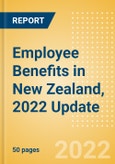New Zealand has a comprehensive social security system, which is largely non-contributory. Neither employers nor employees contribute to social security funds, as they are tax-financed. However, employees and self-employed persons must contribute to the Accident Compensation Corporation (ACC) scheme, which provides benefits in the event of an accident, either at work or elsewhere. New Zealand nationals, permanent residents, and foreign workers temporarily employed in the country are all covered by social security. Work and Income New Zealand (WINZ) administer social security benefits in New Zealand. There is a subsidized retirement savings plan - KiwiSaver - that supplements the country's flat-rate universal pension, known as New Zealand Superannuation. Unemployment and sickness benefits are paid after a minimum period of residence (two years for unemployment benefit), irrespective of employment history. However, the country has reciprocal agreements with certain countries such as Australia, Canada, Denmark, and the UK, under which nationals from these countries can apply for social security benefits as soon as they arrive to take up permanent residence. Social security benefits are offered at a flat rate (government transfers), irrespective of previous income. Benefits are subject to taxation, and the Department of Social Welfare deducts the tax before granting benefits.
The report provides in-depth industry analysis, information, and insights of the employee benefits in New Zealand, including an overview of the state and compulsory benefits in New Zealand, detailed information about the private benefits in New Zealand, insights on various central institutions responsible for the administration of the different branches of social security and the regulatory framework of the employee benefits in New Zealand.
The report provides in-depth industry analysis, information, and insights of the employee benefits in New Zealand, including an overview of the state and compulsory benefits in New Zealand, detailed information about the private benefits in New Zealand, insights on various central institutions responsible for the administration of the different branches of social security and the regulatory framework of the employee benefits in New Zealand.
Key Highlights
- Ministry of Social Development (MSD) is responsible for providing employment, income support, superannuation services, funding to community service providers, social policy, student allowances, and social housing assistance
- Inland Revenue is responsible for collecting and disbursing social support programs. The Inland Revenue also acts as a central administrator to KiwiSaver
- Employment New Zealand is a part of the Ministry of Business, Innovation, and Employment. It is responsible for providing information regarding minimum employment standards and deals with employment-related issues
Scope
This report provides a detailed analysis of employee benefits in New Zealand:- It offers a detailed analysis of the key government-sponsored employee benefits, along with private benefits
- It covers an exhaustive list of employee benefits, including retirement benefits, death in service, long-term disability benefits, medical benefits, workmen's compensation insurance, maternity and paternity benefits, family benefits, unemployment, grant-in-aid, social relief distress, compensation, leaves and holidays and private benefits
- It highlights the economic and regulatory situations relating to employee benefits in the New Zealand
Reasons to Buy
- Make strategic decisions using in-depth information related to employee benefits in the country
- Assess employee benefits of the market, including state and compulsory benefits and private benefits
- Gain insights into the key employee benefit schemes offered by private employers in the country
- Gain insights into key organizations governing employee benefits market, and their impact on companies
Table of Contents
1. Executive Summary3. Country Statistics4. Overview of Employee Benefits in New Zealand5. Regulations
2. Introduction
6. State and Compulsory Benefits
7. Private Benefits
List of Tables








